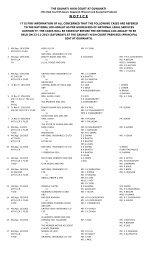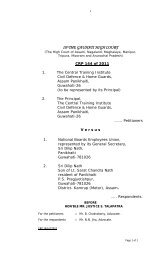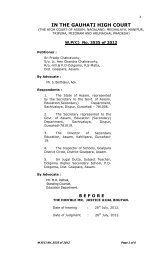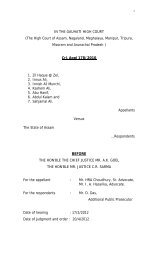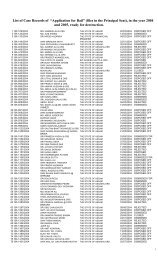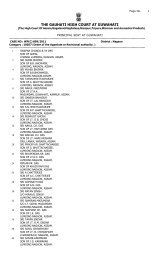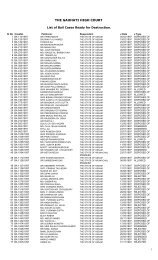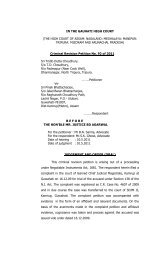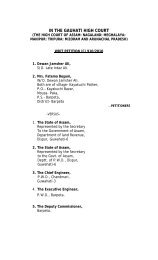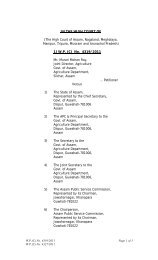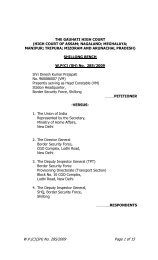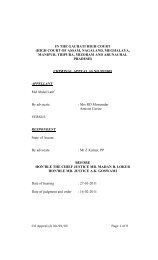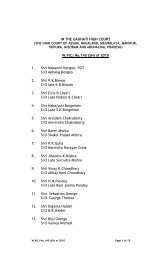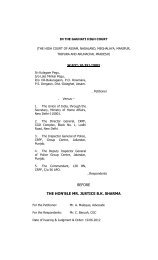CRL.A(J) 141/2007 - Gauhati High Court
CRL.A(J) 141/2007 - Gauhati High Court
CRL.A(J) 141/2007 - Gauhati High Court
Create successful ePaper yourself
Turn your PDF publications into a flip-book with our unique Google optimized e-Paper software.
1IN THE GAUHATI HIGH COURT(THE HIGH COURT OF ASSAM, NAGALAND,MEGHALAYA,MANIPUR, TRIPURA, MIZORAM AND ARUNACHALPRADESH)Criminal Appeal NO. <strong>141</strong>(J) of <strong>2007</strong>Md. Abdul Majid,Son of Late Shaikh Chand,Resident of village Dakshin Moirabari,P.S. Moirabari,District- Morigaon, Assam.……….APPELLANT.- VERSUS -The State of Assam……RESPONDENT.B E F O R EHON’BLE CHIEF JUSTICE MR. A.K. GOELHON’BLE MR. JUSTICE C.R. SARMAFor the appellant : Mr. K.K. Goswami,Amicus Curiae.For the respondent : Mr. K. Mazumdar,Addl. PublicProsecutor, Assam.Date of hearing : 6.1.2012Date of Judgment and order::: 19.03.2012(C.R. Sarma, J)JUDGEMENT AND ORDER(CAV)1. This appeal is directed against the judgment andorder, dated 25/1/2005, passed by the learned Sessions Judge,
2Morigaon, in Sessions Case No. 33/03, under section 302 IPC. Bythe impugned judged and order, the learned Sessions Judgeconvicted the appellant under section 302 IPC and sentenced himto suffer rigorous imprisonment for life and pay a fine of Rs.1,000/- and in default to undergo rigorous imprisonment foranother period of one month.2. We have heard Mr. KK Goswami, learned Counselengaged by the Legal Aid Committee and Mr. K. Mazumdar,learned Additional Public Prosecutor, Assam.The prosecution case, in brief, is that, on 10/4/2002at about 7.15 P.M., while Abdul Razzak (hereinafter called thedeceased) was returning home from the market the appellantintercepted him on the road, near the old Post Office andassaulted with a sharp weapon, causing injuries to his person.Accordingly the deceased was taken to Moirabari Hospital,wherein he succumbed to the injuries.4. Md. Samsul Alam, son of the deceased, lodged anFIR, on the same date at about 7 P.M., with the Moirabari PoliceStation. On receipt of the said FIR, Police registered Moirabari PScase No. 13/02 under sections 341/326/302 IPC and launchedinvestigation into the matter. During the investigation, Policevisited the place of occurrence examined the witnesses, andprepared the inquest report, forwarded the dead body of thedeceased for post mortem examination, seized a pair of bloodstained Hawai Chappal, one pair of rubber sandal and a bloodstained dagger from the place of occurrence. At the close ofinvestigation, Police submitted charge sheet under sections341/302 IPC against the appellant and forwarded him to the<strong>Court</strong> to stand trial.5. The offence being exclusively triable by the <strong>Court</strong> ofSessions, the learned Chief Judicial Magistrate, Morigaon
3committed the case for trial and the learned Sessions Judgeframed charge under section 302 IPC. The charge was read overand explained to the appellant, to which he pleaded not guiltyand claimed to be tried.6. In order to prove its case, prosecution examined asmany as nine witnesses, including the Medial Officer (PW3), whoperformed the autopsy, the Circle Officer (PW7), who conductedthe inquest and the Investigating Officer (PW9). At the close ofthe evidence for the prosecution, the accused person wasexamined under section 313 of the Code of Criminal Procedure1973. He denied the allegations, brought against him anddeclined to adduce defence evidence. Considering the evidence,on record, the learned Trial Judge held the accused/appellantguilty and accordingly convicted and sentenced him as indicatedabove.7. Mr. K. K. Goswami, learned counsel appearing for theappellant has submitted that there is no sufficient substantialevidence against the appellant and that the learned Trial Judgecommitted error by relying on the evidence of the solitary eyewitness i.e. PW4. The learned counsel has also urged that theappellant is about 90 years old and as such, considering his age,a lenient view should be taken for facilitating his release at thislate stage of his life.Mr. K. Mazumdar, learned Additional PublicProsecutor, taking this <strong>Court</strong> through the evidence, on record,more particularly, the evidence of PW4, has submitted that theoccurrence took place in the presence of PW4 and as such PW4 isthe most natural witness in the case. Learned Additional PublicProsecutor has also submitted that there is sufficient substantiveevidence, indicating the guilt of the appellant and that the
4learned Trial Judge committed no error by convicting andsentencing the appellant.8. In order to appreciate the counter submissions, madeby the learned counsel appearing for the parties, we feel itappropriate to, briefly, scan the evidence on record.9. Md. Samsul Haque, PW4 stated that, on the date ofoccurrence i.e. 10/4/2002 at about 7.15 to 7.30 P.M., he wasreturning home, along with the deceased from the Moirabarimarket and on their way home, the appellant, being armed with adagger, had attacked the deceased on the road. This witnessstated that, on being so attacked by the appellant, though he hadraised alarm, nobody came forwarded. According to this witness,in the meantime a person, riding a motorcycle, crossed them andin the focus of the light of the said motorcycle, he saw theappellant assaulting the deceased in his stomach with a dagger.He also stated that he had rushed to the Police Station and mettwo police personnel, at the bus syndicate, to whom he hadreported about the occurrence. According to this witness, onbeing so informed, police persons had visited the place ofoccurrence. PW4 further stated that he also accompanied thepolice and came to know that the appellant, while trying to fleeaway, was caught by the public. He also stated that somepersons had taken the deceased to the Hospital where heexpired. According to this witness, on the next day, heaccompanied the police to the place of occurrence, wherefromtwo pairs of Hawai Sandals were seized vide Exhibit 2. He statedthat the said Hawai Sandals belonged to the appellant and thedeceased. This witness was duly cross-examined on behalf of thedefence. He denied the suggestion, put to him, that, at the timeof occurrence, no motorcycle had passed through the place of
5occurrence and that he did not, see the assailant, in the focus ofthe light of the said motorcycle.10. Md. Babul Islam, PW1, son of the deceased, statedthat, on the date of occurrence at about 10 A.M., a quarrel hadtaken place between his father and the appellant and that theaccused had threatened his father intimidating him that should hevisit the market, he would be killed. According to this witness, onthe fateful day his deceased father returned home from themarket, followed by him. He further stated that hearing hue andcry, he rushed to the place of occurrence and the accusedperson, who tried to run away, had fallen into a drain, wherefromhe was taken to custody by the public. According to this witness,his father being already shifted to the Hospital, he could not findhim in the place of occurrence. He further stated that, on beingasked by him, his father had told him that the appellant hadassaulted him. This witness lodged the FIR as the informant. Hehas exhibited the FIR as Exhibit 1 and his signature thereon asExhibit 1(1). In his cross-examination, he admitted that he didnot tell the Police regarding the quarrel, which had taken place inthe morning and about the threat given to his father by theappellant. He also admitted that he did not tell the police that hehad rushed to the place of occurrence and visited his father in theHospital. He stated that he was not examined by the police andthat the FIR was written by one Mr. Alam, on being asked by him.11. Mr. Nazimuddin deposed as PW2. He was anindependent witness. He stated that while returning from themarket, he, hearing screaming cry, rushed to the place ofoccurrence and saw the deceased and the appellant pushing andpulling each other. According to this witness, the appellant, whohad ran away, after assaulting the deceased with a dagger on hisstomach, was caught by some persons. He also stated that, in
6the meantime, a motorcycle arrived there and in the focus of thelight of the motorcycle, he could identify the deceased and theappellant. According to this witness, the deceased was taken tothe Hospital, wherein he died. In his cross-examination, thiswitness stated that 15 minutes after the hearing of the screamthe motorcycle had arrived there and that in the meantime 10 to15 persons had assembled there. He denied the suggestion that,before the Investigating Officer, he did not disclose about thehearing of screaming cry and the assault caused by the appellant.12. The Medical Officer who performed the autopsy hasbeen examined as PW3. During the post mortem examination,PW3 found the following injuries:-(1) Incised wound over right arm 3cm x .5 cm x 1cm. Injuries are cleancut and everted.(2) Punctured wound over right hypochondrium of size 3cm x 1cmpenetrating the abdominal wall. The edge of the injury is evertedand clean cut on examination under magnifying glance.The said Medical Officer opined that the injuries wereante-mortem and caused by sharp weapon. He exhibited the postmortem report as Exhibit No. 3 and his signature therein asExhibit 3(1).13. Mr. Abdul Jalil, who deposed as PW5, stated that, onthe date of occurrence, at about 7.30 P.M., hearing hue and cry,he rushed to the place of occurrence and came to know that amurder had taken place. He did not find the injured in the placeof occurrence, but he came to know that injury was caused to thedeceased.Mr. Ikramul Hussain, deposing as PW6, stated aboutthe seizure of the dagger by the police vide Exhibit No. 4.According to this witness, the dagger was seized by the Policefrom the roadside.
714. PW7 was the Circle Officer, who conducted theinquest in respect of the dead body of the deceased. He exhibitedthe inquest report as Exhibit No. 5.15. Mr. Khursed Ali, who deposed as PW8, stated that,hearing about the incident, he went to the police station and sawthe dead body of the deceased.16. From the evidence of Mr. Sibal Kumar, PW9, Sub-Inspector of Police, it is found that the investigation wasconducted by Sub-Inspector Shri Umakanta Rajkhowa. From hisevidence, it is found that, on receipt of information, about theincident, police made a GD Entry, being GD Entry No. 268 dated10/4/2002 and proceeded to the place of occurrence. The saidGD has been exhibited as Exhibit 6 and the relevant GD Entry isExhibit 6(1). From his evidence, it is also found that a writtencomplaint, i.e. Exhibit 1, was receipt after the police had initiatedthe investigation. This witness further stated that charge sheetwas submitted by Mr. Rajkhowa. The said Police Officer, whoconducted the investigation and examined the witnesses, has notbeen examined in this case.17. From the evidence on record, more particularly, theevidence rendered by the prosecution witnesses, it is found thatthe deceased died, on 11/4/2002, due to the injuries sustained byhim. From the medical evidence, it is found that the injuries werecaused by sharp cutting weapon.18. Now the question is as to who had caused the saidfatal injuries. The prosecution version is that the appellant hadintercepted the deceased, on the road and inflicted the said fatalinjuries with a dagger. The plea of the appellant is that he did notcommit the said act.Law is well settled that in a criminal trial, it is theburden of the prosecution to prove the charge, brought against
8the accused person, beyond all reasonable doubt. Once the saidburden is discharged, the liability shifts to the accused person toprove his innocence.19. In view of the above discussed evidence, as revealedby the prosecution witnesses, we are required to scrutinise if theprosecution could establish that the appellant caused the death ofthe deceased.20. Md. Babul Islam, PW1, son of the deceased claimedthat hearing alarm, he arrived at the place of occurrence andfound that his father was already shifted to the Hospital, forwhich he too rushed to the Hospital and that, in the Hospital, hisfather made a dying declaration. He lodged the FIR, immediatelyafter the occurrence. But in the said FIR (Exhibit 1), no disclosurehas been made about the said dying declaration. Withholding ofsuch vital information from the FIR, which was lodged at theinitial stage i.e. immediately after the occurrence, raises doubtabout the veracity of the evidence of PW1. That apart, none ofthe prosecution witnesses more particularly the brother of PW1,i.e. PW4, who also claimed to be an eye witness, did not whisperanything about the dying declaration, who asserted that thedeceased had made dying declaration, should have disclosedsuch vital information to others, more particularly to his brother.The silence of other witnesses, regarding dying declaration,indicates that PW1 did not disclose about such declaration toanyone. That apart, as admitted by PW1, he was not examinedby the police. He, for the first time, disclosed about the dyingdeclaration, at the time of giving evidence in the trial. Thisconduct, on the part of PW1, make it unsafe to rely on hisevidence and, therefore, we are not inclined to rely on theuncorroborated evidence of PW1.
921. According to PW2, the incident took place in hispresence. He clearly stated that hearing noise, he rushed to theplace of occurrence and saw both the appellant and the deceasedscuffling with each other. According to this witness, after about15 minutes of the hearing of the noise, a motorcycle had arrivedand in the focus of the light of the motorcycle, he could recognisethe deceased. Here we may take a pause and apply our mind tothe evidence given by PW2 and PW4.According to PW2, 15 minutes after hearing the noise,the motorcycle had come and he could recognise the deceased inthe light of the motorcycle. This indicates that it was a dark nightand as such it was not possible to recognise any person, withoutartificial light. There is nothing, on record, to show that there wasany streetlight or other natural light. The evidence of PW2 thathe recognised the deceased, in the focus of the light of themotorcycle, indicates the absence of any other artificial or naturallight. According to PW2, before inflicting the fatal blows, a scufflehad taken place between the deceased and the appellant and itcontinued for about 15 minutes. From the evidence of PW2, it isalso found that at the time of arrival of the motorcycle, already10 to 15 persons had gathered at the place of occurrence.But PW4, another son of the deceased, who claimed tobe an eyewitness, stated that he had accompanied his fatherfrom the market and he was present with his father, at the timeof occurrence. According to PW4, his father, being attacked bythe appellant, he had raised alarm seeking help, but nobodycame forward. He also stated that, in the meantime, a motorcyclehad arrived and in the focus of the motorcycle he could see theappellant, giving blows, with a dagger, on the stomach of hisfather.
10According to PW4, he was alone with his father, at thetime of occurrence and he could see the appellant, inflicting thefatal blows, in the focus of the light of the motorcycle. Thisindicates that the fatal blow was inflicted as soon as themotorcycle had passed through the place of occurrence, butaccording to PW2, the motorcycle had arrived after theoccurrence and at the time of arrival of the motorcycle about 10to 15 persons had gathered there.Therefore, a comparative study of the evidence of PW2and PW4, who claims to be the eye witness to the occurrence,reveals that according to PW2, prior to occurrence, a scuffle hadtaken place between the deceased and the appellant and thedeceased had inflicted the injuries before the arrival of themotorcycle and when the motorcycle arrived, already 10 to 15persons had assembled there, but PW4 is silent about suchscuffling and presence of PW2. If PW2’s evidence is believed thenit must be held that PW2 was present at the place of occurrence.The evidence of PW2 negates the presence of PW4. On the otherhand, the evidence of PW4 also belies the evidence of PW2regarding his presence in the place of occurrence. PW4 clearlystated that he saw the appellant giving the blow with a dagger inthe focus of the light of the motorcycle, which was moving inslow speed. Therefore, the source of light, in which PW4 couldidentify the appellant, was the light of the motorcycle. But,according to PW2, the blows were given before the arrival of themotorcycle and PW2 could recognise the deceased in the focus ofthe light of the motorcycle. That apart, by the time themotorcycle arrived, about 10 to 15 persons had already gatheredthere. But according to PW4, he was there at the time of arrivalof the motorcycle and despite asking for help nobody hadresponded.
11In view of the said contradictory evidence given by PW2and PW4, we do not find it safe to rely on their uncorroboratedevidence.We have already noticed that the evidence of PW1regarding dying declaration is not believable. If the evidence ofPW2 and PW4 is not taken into confidence, there remains nosubstantive evidence against the appellant. Neither the seizedweapon nor the chappals were sent for forensic examination forestablishing the involvement of the appellant. Therefore, theseizure of the said articles do not substantiate the involvement ofthe appellantIn the light of the above discussion, we are inclined tohold that the prosecution failed to prove the case, beyond allreasonable doubt. Therefore, the appellant is entitled to get thebenefit of doubt. Accordingly, we allow this appeal. Consequently,the appellant is acquitted. He be set at liberty forthwith, if notrequired in any, other case.Return the lower court records.JUDGECHIEF JUSTICERA



